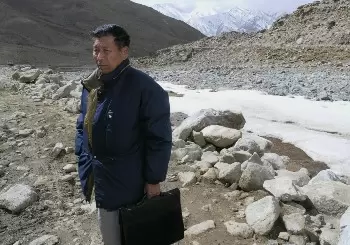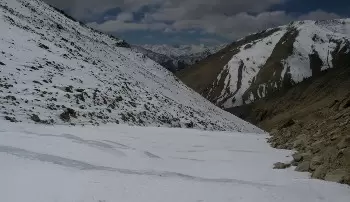He built reservoirs that froze in winter and melted in summer to help farmers

29-March-2013
Vol 4 | Issue 13
Chewang Norphel is nearing 80, and is not in the best of health. But that does not stop him from speaking about the ‘artificial glaciers’ he had built in Ladakh to help farmers in the region.
The ‘glacier man,’ as Norphel is known, has built reservoirs near villages located in altitudes of around 13000 feet, where water is stored from the melting snow in summer.
 |
|
Chewang Norphel built 12 artificial glaciers that provided water for farmers in Ladakh (Photos by Mahesh Bhat)
|
This water freezes in winter and turns into ice - an artificial glacier. The ice melts in April to provide water for farmers during the sowing season.
Natural glaciers, on the other hand, are located at higher altitudes, at about 18000 feet. They need few more weeks to melt and feed the streams with water. However, by then it is too late for the famers to begin sowing and get a full harvest before onset of winter.
Norphel was moved by the condition of the farmers.
Lack of livelihood opportunities in the villages led to migration of locals to nearby towns, where they took up low paying menial jobs.
Those who persisted in agriculture opting for a compressed cycle of the cultivation process obtained low produce. They earned little and lived in poverty.
As an engineer in Jammu& Kashmir government’s rural development department, Norphel analysed the problem and tried to find a solution. In later years, he would develop the artificial glaciers.
These glaciers, he believed, would provide fresh water to the parched and cold fields and change the fortunes of the villagers for whom life was an everyday struggle in one of the most treacherous terrains in the world.
“As a civil engineer of the rural development department, I visited most of these villages and saw the utter helplessness of these simple yet hardworking Buddhists. Watching how water froze during winter months, I decided to experiment with reservoirs and see if that would help provide fresh water supply in April,” says the 78-year-old.
He built his first artificial glacier near Phuktse Phu village and it worked wonders for the local populace. The villagers reaped a good harvest in the first year itself due to the availability of water in April.
Norphel joined the Leh Nutritional Institute in 1996 and started building artificial glaciers in several small and nondescript villages of Ladakh.
The sites were carefully selected to ensure that the glaciers did not thaw until April when farmers needed a continuous supply of fresh water for the sowing.
Wheat, barley, peas and potatoes are the major crops grown in the region. After the introduction of these artificial glaciers, the agricultural production went up by 2-3 times and the local economy started showing signs of revival.
“Farmers growing peas and potatoes saw a massive spurt in their yield. In some villages the production went up by 4 -5 times,” recalls Norphel.
He was soon being addressed as the ‘glacier man’ and felicitated for his pioneering work.
Norphel received many prestigious awards for his breakthrough work.
He built around 12 artificial glaciers. His largest glacier measured about 1000 feet long, 150 feet wide, and 4 feet in depth.
 |
|
Norphel's artificial glaciers thawed in April, the period when farmers needed water most
|
“A single glacier can easily cater to 3-4 villages with populations of around 300 to 3000 people,” he says.
There are other advantages as well. The glaciers can be built at one fourth the cost of a cement reservoir.
They are built with local materials and can be easily maintained by villagers. Such was his watershed programme that many countries invited Norphel to teach them the technique.
In 2010, flash floods destroyed many of Norphel’s glaciers. “It was unfortunate as too much time and energy had been spent on building them. We now have close to 3-4 glaciers that are fully functional,” he says.
Norphel has been diagnosed with a heart condition and doctors have strictly asked him to avoid any stress. He is at present recuperating in Jammu as the weather is too harsh for him in Leh and he is not sure whether he will be able to devote the same attention to his beloved project ever.
But Norphel has trained people to continue his work. “Leh Nutritional Institute is still working on restoring these glaciers and creating new ones. I am getting too old for all this. I have showed them the way and I am sure that they will continue with it,” he says.
Norphel’s story is inspirational and proves how human grit and perseverance can even move mountains. In his case it created glaciers.
















